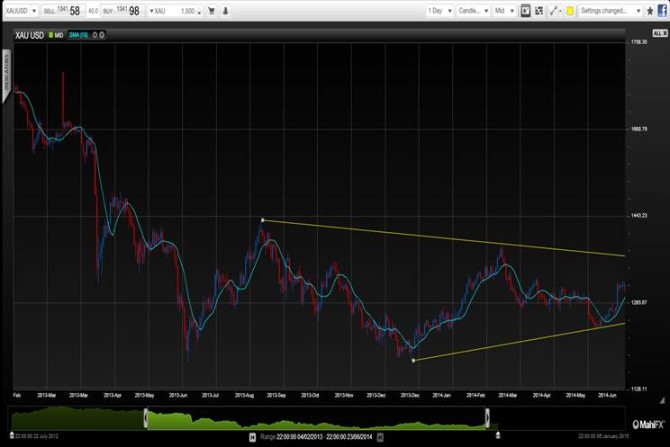Gold appears to have bottomed out and could be the in the process of making a comeback, albeit a timid one, which could gather momentum due to the world’s increasingly unstable geopolitical environment.
There are a number of bullish factors for gold. The first is that the market has been steadily recovering from lows seen in June and December 2013. It has been doing this against a backdrop that should be negative for gold i.e. the winding down of the US Federal Reserve’s quantitative easing programme, which may be complete by October.
By Justin Pugsley, Markets Analyst MahiFX Follow @MahiFX on twitter
A second factor is that gold has largely dropped out of the headlines and is out of favour with many investors. For a market to be able to move higher, despite apathy, is often a positive sign.
But that’s not all.
Gold consolidates

An environment made for gold
Geopolitically the world is looking increasingly unstable. Countries such as Russia, Iran and China are keen to fill any perceived power vacuum left by a US still scarred from the financial crisis and a series of very expensive overseas military adventures. Then there’s the Middle East where the ‘Arab spring’ seems to have degenerated into a perpetual cycle of violence and instability.
Add to that concerns over the potential negative impact on the world economy, the possibility of plunging stock markets and there is an emerging toxic cocktail in which gold can thrive. Some gold enthusiasts even expect the Fed to resume QE at some point due to a weakening US economy. If that did happen it would set the gold market on fire. But for now a resumption of QE seems unlikely.
Gold hit a low of around $1,180 troy/oz. in June 2013 and a slightly higher low in December 2013 after falling from all-time highs of around $1,921 in September 2011. This appeared to be the end of a 12-year rally, but in the context of that time frame the market is still bullish.
Since June 2013 the market has been in a consolidation pattern, so at the very least has stopped falling and may even be starting to work its way higher. Key resistance levels to look out for include $1,392 and it would need to clear $1,435 to break out of the current consolidation pattern.
Among the key long-term Fibonacci numbers are the 38.2% retracement level at $1,463 and the 50% at $1,550, which could prove very influential for the gold market if they are breached.
Nonetheless, traders should be aware that the gold market could easily remain in its consolidation pattern for another 6 to 12 months.
For more about gold, see Trading NRG
